
Musca is a small constellation in the deep southern sky. It was one of 12 constellations created by Petrus Plancius from the observations of Pieter Dirkszoon Keyser and Frederick de Houtman, and it first appeared on a celestial globe 35 cm (14 in) in diameter published in 1597 in Amsterdam by Plancius and Jodocus Hondius. The first depiction of this constellation in a celestial atlas was in Johann Bayer's Uranometria of 1603. It was also known as Apis for 200 years. Musca remains below the horizon for most Northern Hemisphere observers.

NQ Vulpeculae also known as Nova Vulpeculae 1976, was a nova that appeared in the constellation Vulpecula in 1976. It was discovered visually at 18:20 UT on October 21, 1976 by English amateur astronomer George Alcock. Its apparent magnitude at the time of discovery was 6.5 It reached its maximum brightness of magnitude 6.0 thirteen days after its discovery, at which point it may have been faintly visible to the naked eye. A few days after maximum brightness, it had faded to magnitude 8.3.
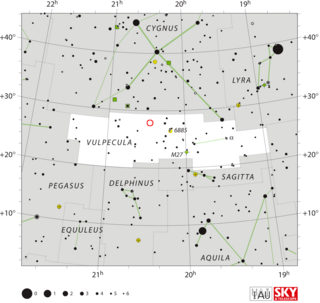
QU Vulpeculae, also known as Nova Vulpeculae 1984 Number 2, was the second nova which occurred in 1984 in the constellation Vulpecula. It was discovered by Peter Collins, an amateur astronomer from Cardiff, California at 22:08 UT on 22 December 1984. At the time of its discovery, the nova's apparent magnitude was 6.8. By the next night, Collins reported its brightness had increased to magnitude 5.6, making it visible to the naked eye.
The gamma-ray and X-ray source GRS 1124-683, discovered by the Granat mission and Ginga, is a system containing a black hole candidate. The system also goes by the name X-ray Nova Muscae 1991 or GU Muscae. These two orbiting X-ray telescopes discovered the system when the system produced an outburst of X-rays on January 9, 1991.

Delta Muscae, Latinized from δ Muscae, often catalogued as HD 112985, is a spectroscopic binary star system and the closest to the Earth in the southern hemisphere constellation of Musca at a distance of approximately 27.8 parsecs. The main star is classified as a giant star with an orange tint. It is one of the stars given a Bayer designation by astronomer Johann Bayer. It was recorded in Bayer's 1603 publication Uranometria. In addition it is one of the main stars used in the visual formation of the Musca constellation.
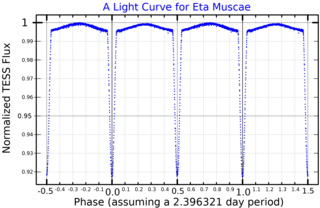
Eta Muscae is a multiple star system in the southern constellation of Musca. It is visible to the naked eye as a faint, blue-white hued point of light with an apparent visual magnitude of 4.79. The system is located around 406 light years away from the Sun. It is a member of the Lower Centaurs Crux subgroup of the Sco OB2 stellar association of co-moving stars.

V339 Delphini or Nova Delphini 2013 (PNV J20233073+2046041) is a bright nova star in the constellation Delphinus. It was discovered on 14 August 2013 by amateur astronomer Koichi Itagaki in Japan and confirmed by the Liverpool Telescope on La Palma. The nova appeared with a magnitude 6.8 when it was discovered and peaked at magnitude 4.3 on 16 August 2013. A nova is produced by the fusion of accumulated material on the white dwarf nova progenitor acquired from its companion star. The nova system is thus a binary star, and a classical nova. The white dwarf is a carbon-oxygen white dwarf, with an estimated mass of 1.04±0.02 M☉. There is not yet a consensus about what the binay's orbital period is; estimates range from 3.15 hours to 6.43 hours.

KT Eridani was a bright nova in the constellation Eridanus that produced an outburst in 2009. It was the first classical nova ever detected in that constellation. The nova was discovered at 12:52 UT on 25 November 2009 by K. Itagaki at Yamagata, Japan with a 21 cm patrol telescope. At the time of its discovery, it was a magnitude 8.1 object. The discovery occurred after the nova's peak brightness, but the All Sky Automated Survey system had detected the nova on three earlier occasions, allowing a more complete light curve to be produced. The peak magnitude, 5.4, was seen at 15:10 UT on 14 November 2009.

V1369 Centauri also known as Nova Centauri 2013 was a bright nova in the constellation Centaurus that occurred in 2013. It was discovered on December 2, 2013 by amateur astronomer John Seach in Australia with a magnitude of 5.5. On December 14, 2013 it peaked at about magnitude 3.3, making it the brightest nova so far of this millennium.
Zeta1 Muscae, Latinized from ζ1 Muscae and abbreviated ζ1 Mus, is a suspected astrometric binary star system in the constellation Musca, located 2.6° west of Beta Muscae. It is bright enough to be visible to the naked eye as a dim, orange-hued star with an apparent visual magnitude of 5.73, forming a visual pair with nearby Zeta2 Muscae. The ζ1 Mus system is around 417 light-years distant from the Sun, based on parallax, and is drifting further away with a radial velocity of +21 km/s.
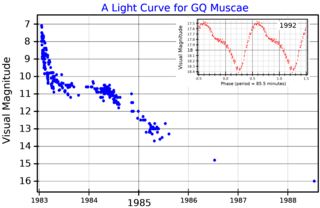
GQ Muscae, also known as Nova Muscae 1983 is a nova in the constellation Musca, which was discovered by William Liller at 03:20 UT on 18 January 1983. At the time of its discovery it was a magnitude ≈7.2 object, and it subsequently faded.

V5856 Sagittarii, also known as Nova Sagittarii 2016 Number 4, was the 4th and brightest nova that occurred in the constellation Sagittarius during 2016. It was discovered by the All Sky Automated Survey for SuperNovae on 25.02 October 2016, at which time it had an apparent visual magnitude of 13.7. It was independently discovered by Yukio Sakurai of Mito, Ibaraki, Japan on 26.38 October 2016, by which time it had reached magnitude 10.4. It reached its peak brightness of magnitude 5.4, making it visible to the naked eye, on 8 November 2016. The nova occurred within a region of the sky monitored by the OGLE microlensing experiment, and that group reported that no star brighter than magnitude 22 was seen at the nova's position prior to its eruption.
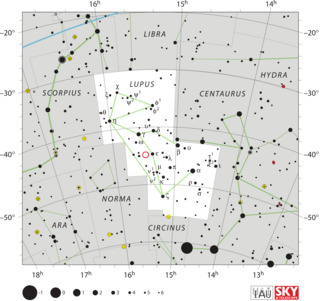
V407 Lupi, also known as Nova Lupi 2016, was a bright nova in the constellation Lupus discovered by All Sky Automated Survey for SuperNovae (ASAS-SN) on 24.00 September 2016. At the time of its discovery, it had an apparent visual magnitude of 9.1. The ASAS-SN team reported that no object at the nova's location brighter than magnitude 17.5 was seen on images taken four days earlier. Wildly incorrect coordinates were published in the announcement telegram, but corrected in a subsequent telegram. It reached a peak brightness of magnitude 5.6, faintly visible to the naked eye, on 25 September 2016.

V5668 Sagittarii, also known as Nova Sagittarii 2015 Number 2 was the second and brighter of two novae in the southern constellation of Sagittarius in 2015. It was discovered by John Seach of Chatsworth Island, New South Wales, Australia on 15 March 2015 with a DSLR patrol camera. At the time of discovery it was a 6th magnitude star. It peaked at magnitude of 4.32 on March 21, 2015, making it easily visible to the naked eye.
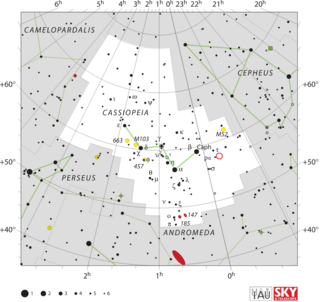
V705 Cassiopeiae, also known as Nova Cassiopeiae 1993 was a nova which erupted in the constellation Cassiopeia during 1993. The nova was discovered at 11:17 UT on 7 December 1993 by amateur astronomer Kazuyoshi Kanatsu of Matsue, Japan, who photographed it using a 35mm camera with a 55mm f/2.8 lens. Asteroid 6976 Kanatsu was named after him in honor of this discovery. At the time of its discovery the nova had a photographic magnitude of 6.5. Around 18 December 1993 it flared briefly to magnitude 5.3, and then it returned rapidly to magnitude 6.5. It underwent a series of smaller flares until mid February 1993, after which it began a precipitous decline in brightness.

FM Circini, also known as Nova Circini 2018, was a nova which appeared in the constellation Circinus in 2018. It was discovered by John Search of Chatsworth Island, New South Wales, Australia on 19.708 January 2018, using a DSLR with a 50 mm F/1.2 lens. At the time of its discovery, it had an apparent visual magnitude of 9.1. It was confirmed to be a nova spectroscopically on 21 January 2018. FM Circini reached a peak brightness of magnitude 5.8 on 22 March 2018, making it visible to the naked eye.

Nova Cassiopeiae 2021, also known V1405 Cassiopeiae, was a nova in the constellation Cassiopeia. It reached a peak brightness of magnitude 5.449 on May 9, 2021, making it visible to the naked eye. It was discovered by Japanese amateur astronomer Yuji Nakamura of Kameyama, Japan, at 10:10 UT on March 18, 2021. The nova was first seen by Nakamura in four 15 second CCD exposures with a 135mm F/4 lens, when it was at magnitude 9.3. Nothing was seen brighter than magnitude 13.0 with the same equipment in exposures taken at 10:12 UT on March 14, 2021. For the first seven months after discovery, the nova's brightness stayed at a rough plateau, fading and rebrightening at least eight times; it is considered a very slow nova. After the seven month long series of peaks, Nova Cassiopeiae began a linear decline in brightness. This nova has been detected throughout the electromagnetic spectrum, from radio to gamma rays.

GT Muscae, also known as 12 Muscae, is a variable star about 400 light years from the Earth, in the constellation Musca. It is a 5th magnitude star, so it should be faintly visible to the naked eye of an observer far from city lights. It is a quadruple star system, consisting of a spectroscopic binary containing an RS Canum Venaticorum variable star, orbiting an eclipsing binary. It varies in brightness from magnitude 4.96 to 5.23. GT Muscae is a very active X-ray source.




















